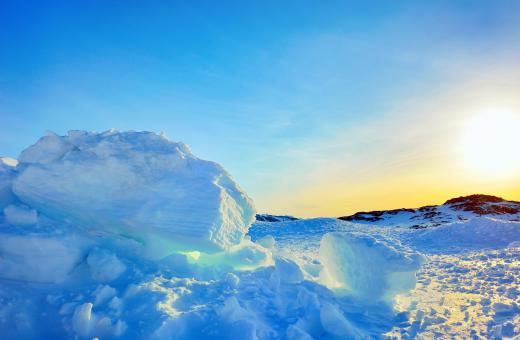What are the Major Ice Ages of the Earth's History?
 Michael Anissimov
Michael Anissimov
The Earth has experienced at least five major ice ages in its 4.57 billion year history: the Huronian glaciation (2.4 to 2.1 billion years ago), the Sturtian/Marinoan glaciation (710 to 640 mya), the Andean-Saharan glaciation (460 to 430 mya), the Karoo Ice Age (350 to 260 mya) and the most recent Ice Age, which is currently ongoing (40 to 0 mya). The definition of an Ice Age is a long-term drop in global temperatures from the historical norm, accompanied by an extension of continental ice sheets. Each Ice Age is cyclical, generally on timescales of 44,000 and 110,000 years, during which glacial ice rhythmically extends and recedes.
The precise causes of historical Ice Ages are unknown, but likely emerged due to a variety of factors, including: positions of the continents, atmospheric composition (greenhouse gases), volcanic activity, the Earth's albedo (reflectivity), variations in the Earth's distance from the Sun (Milankovitch cycles), variations in solar output, and asteroid impacts. When the right variables are in place, an Ice Age begins, and once it gets started, positive feedback effects come into play. The strongest is simply that ice is more reflective than land or forest, so large areas covered in ice sheets reflect away the Sun's rays, causing further drops in temperature and increased glaciation.

Most of the time, the Earth is not in an Ice Age, and the average global temperature is about 22 °C (71 °F). Ice sheets are almost completely absent, found only at high altitudes (alpine glaciers). The poles are cold, but not covered in ice, and forests extend from pole to pole. Dinosaur fossils have been found at less that 10° latitude from the ancient South Pole. Only during about 15% of the Earth's history has there been an Ice Age.

The two most famous Ice Ages are probably the Sturtian/Marinoan glaciation and the most recent Ice Age. The Sturtian/Marinoan glaciation was so severe that evidence of continental glaciers have been found around the equator from this period. The average global temperature may have dropped lower than -30 °C (-22 °F), colder than present-day Antarctica. Some scientists even believe that the oceans froze from top to bottom during this time, resulting in a "Snowball Earth" scenario. Life would have survived in refugia such as deep-sea hydrothermal vents.

The most recent Ice Age is well-known because we humans have had our entire history within it. We think ice sheets covering Greenland and Antarctica are typical, even though they're not. More than about 10,000 years ago, there was a severe glacial period that covered the continents in glaciers as far south as Chicago and Paris. During this time period, humans had to mostly avoid colonizing Europe or northern Asia, as these areas were frozen solid. For this reason, human fossils predating the last glacial period are found only in Africa, the Middle East, China, Southeast Asia, Australia, and only small parts of Europe such as Spain and southern France.
AS FEATURED ON:
AS FEATURED ON:















Discussion Comments
How often did this ice age happen in the years that it was happening? or was it non-stop?
@Armas1313
What we're looking at for this kind of a tangent is a period of millions of years. It will probably be a very long time before Antarctica could be habitable, and a lot of disaster would occur due to melting. Hopefully this kind of melting occurs more slowly than it seems to be.
The earth seems to be on a tangent of warmth and coldness. At this point it seems that we are warming up. I wonder if Antarctica will ever be habitable.
The levels in certain lakes of the world changed due to the ice age. As a result, some lakes were separated into various lakes, resulting in variance of fish life. When the lakes rose again, these different fish were re-introduced as separate species, and learned to survive off of each other symbiotically and in competition.
Post your comments